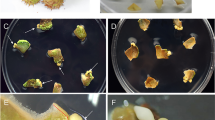Abstract
An embryogenic suspension culture of Zea mays, genotype 4C1, was obtained from friable callus that was cultured on solid medium and had been obtained from zygotic embryos. The suspension contained non-dividing elongated cells, clusters of dividing isodiametric cells, and globular, ovoid, and polar stages of somatic embryos. The single somatic embryos were blocked in shoot meristem formation: when transferred to regeneration medium they developed a root and, at the shoot side, a green cap with meristematic cells, but a scutellum and leaf primordia were not formed. In medium containing 2,4-dichlorophenoxy acetic acid, somatic embryos formed embryogenic callus aggregates, consisting of globular stage somatic embryos attached to each other via undifferentiated callus cells. These somatic embryos developed into mature embryos with the zygotic histological characteristics, such as scutellum and leaf primordia, in maturation medium, and then regenerated into plants in regeneration medium. By omitting the maturation phase, regeneration occurred via organogenesis. Polyembryos, i. e. embryos attached to each other without callus tissue in between, behaved as single somatic embryos. It is concluded that the attached callus tissue provides a factor that stimulates scutellum and leaf primordia formation.
Similar content being viewed by others
Abbreviations
- CMM:
-
callus maintenance medium
- 2,4D:
-
2,4-dichlorophenoxy acetic acid
- PCV:
-
packed cell volume
- MS:
-
Murashige and Skoog medium
References
Conger BV, Havanesian JC, Trigiano RN, Gray DJ (1989) Cro Sci. 29: 448–452
Chu CC, Wang CC, Sun CS, Hsu C, Yin KC, Chu CY, Bi FY (1975) Sci. Sin. 18: 659–668
Fransz PF, Schel JHN (1991) Can J. Bot. 69: 26–33
Mórocz S, Donn G, Nemeth J, Dudits D (1990) Theor. Appl. Genet. 80: 721–726
Mórocz S, Dudits D, Nemeth J (1986) In: Somers DA, Gegenbach BG, Biesboer DD, Hackett WP, Green CE (eds) VI Int. Congr. Plant Tissue and Cell Culturere Minneapolis. p. 190
Murashige T, Skoog F (1962) Physiol. Plant. 15: 473–497
Prioli L, Sondahl MR (1989) Biotechnology 7: 589–594
Rhodes CA, Lowe KS, Ruby KL (1988) Biotechnology 6: 56–60
Schel JHN, Kieft H, Van Lammeren AAM (1984) Can. J. Bot 62: 2842–2853
Sheridan WF (1988) Ann. Rev. Genet. 22: 353–385
Shillito RD, Carswell GK, Johnson CM, DiMaio JJ, Harms CT (1989) Biotechnology 7: 581–587
Van Lammeren AAM (1988) Acta Bot. Neerl. 37: 49–61
Vasil IK (1988) Biotechnology 6: 397–402
Vasil V, Vasil IK (1986). J. Plant Physiol. 124: 399–408
Walthall ED, Brady T (1986) Cell Differentiation 18: 37–44
Author information
Authors and Affiliations
Additional information
Communicated by H. Lörz
Rights and permissions
About this article
Cite this article
Emons, A.M.C., Kieft, H. Histological comparison of single somatic embryos of maize from suspension culture with somatic embryos attached to callus cells. Plant Cell Reports 10, 485–488 (1991). https://doi.org/10.1007/BF00234578
Received:
Revised:
Issue Date:
DOI: https://doi.org/10.1007/BF00234578




